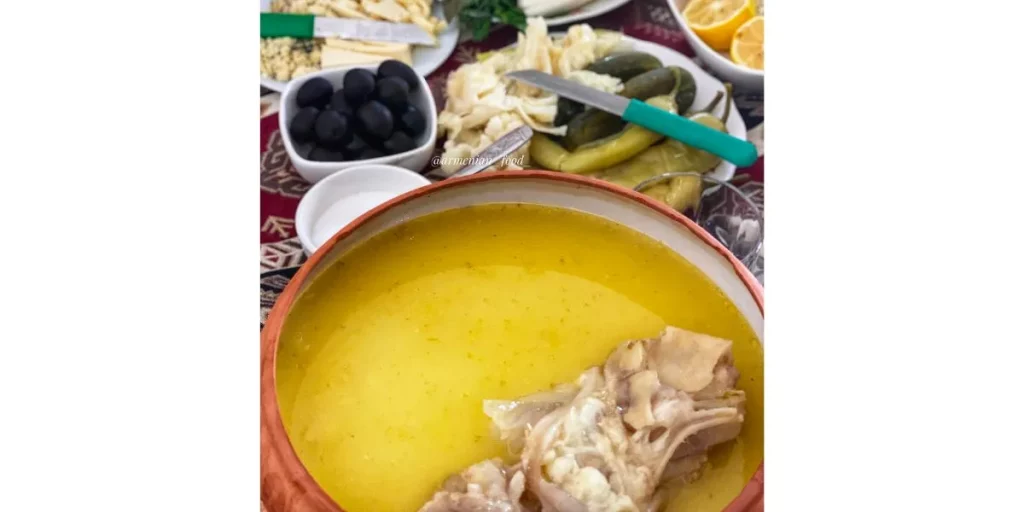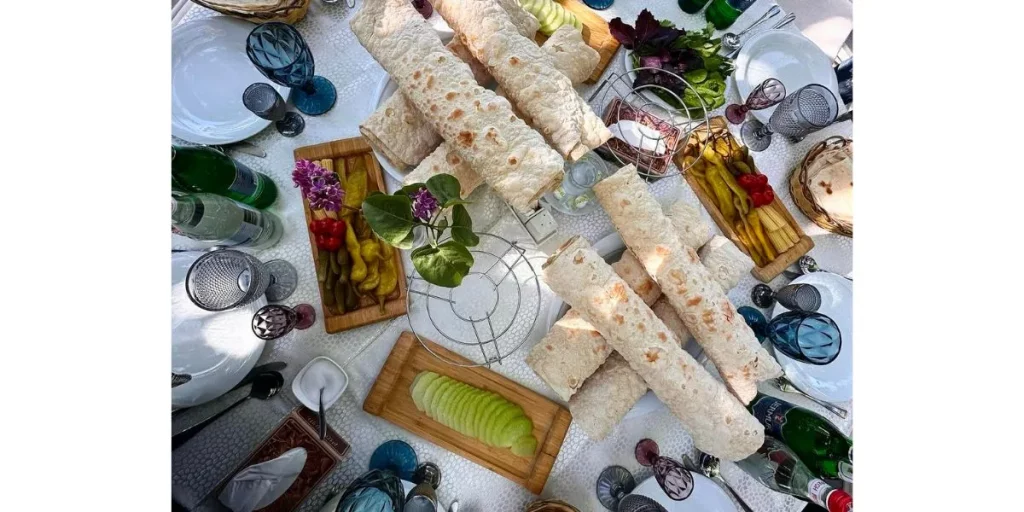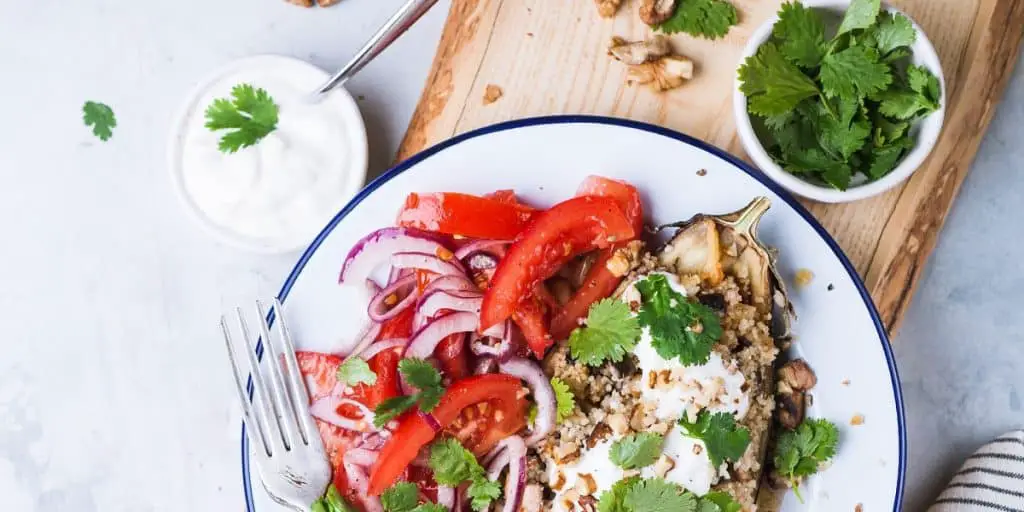I am going to talk about a unique dish today. If you are a fan of unusual dishes, then traditional Armenian khash might interest you. This flavorful dish is the favorite of many Armenians. It has a special place in Armenian cuisine, as it’s often served at family and community gatherings, and therefore has a strong symbolism of social bonding associated with it. In this post, we will dive into its origins, nutritional value, ways of eating khash, and its presence in other regions and countries.
Traditional Armenian khash is a savory dish (a soup) made from boiled cow or sheep parts such as the head, feet, and stomach. It is typically served for breakfast, because it is very heavy and filling. Known as ‘khashi’ in Georgian and ‘xaş’ in Azerbaijani, this centuries-old dish is typical of the traditional cuisine of the South Caucasus region.
Now, with the basic definition being out of the way, let’s look at khash in more detail. And if you like this post and you want to share your thoughts on this dish with me, ping me on Twitter or Instagram with #ArmeniaTravelTips.

Origins of traditional Armenian khash
According to a legend about the origins of khash, when rich people cut cows and sheep to eat the meat, they threw away the legs and entrails for dogs. The poor neighbors would secretly take the feet and stomach, boil them, and eat the broth with garlic and lavash flatbread.
One day a rich man went to his poor neighbor’s house where he got a chance to taste khash. He liked it so much that he decided to make it himself. But because he was rich, he was ashamed to eat cow legs. That’s why he cooked the dish at night so that nobody would see it, and he ate it in the morning for breakfast. Since then, Armenians eat khash early in the morning.
This is of course a legend. The real historical origin is probably explained by the need to be pragmatic about the use of every part of the animal after the slaughter. And despite the fact that what goes into khash are predominantly quite cheap and unappealing parts of a cow, the resulting broth is so filling and flavorful that it had to become a staple among the population.

Armenian khash recipe
I don’t think it would be too much of an exaggeration if I say that every Armenian who has any degree of interest in cooking has their favorite recipe for cooking khash. It’s also worth mentioning that in Armenian culture, along with khorovats (barbeque), khash is one of those dishes that are traditionally cooked by men.
Preparation
Cooking khash requires a lot of strength and patience. Typically, you make it for a large group of people, so you’d need a large pot. The process is really very long. In the old days when in villages a family would slaughter their cow, family members may spend up to several days cleaning the meat from excess hair and debris. They’d need to keep the meat in cold water and change the water from time to time, to remove the unwanted animal flavors from it.
These days Armenians would typically buy already cleaned and ready to be cooked cow feet and stomach from the local butcher. You can also easily find the necessary parts of meat for khash in Armenian supermarkets in big cities. It shows that despite the times moving forward, khash is one of the traditions that remains in our lives.
Cooking khash
Now, let’s move to cooking itself. Cooking khash takes a lot of time too. It typically starts as soon as the sun goes down the day before the khash-eating event is planned for. We place the feet and stomach in a large pot and cover them with enough water to fully submerge them. After that, we bring the mixture to a boil over heat. Then we reduce the heat to low and let it simmer gently for several hours.
It’s really important to give enough time to khash to meld together and create a rich and aromatic broth. That is why, normally we cook khash overnight, so that it is ready for the next day – for breakfast. If you wanna see the khash cooking process, check out this cooking video from Gasia.
Serving and eating khash
Armenian khash is not just a dish. It’s an experience, an event! It’s not just about eating a meal but sharing social and cultural experiences together. So, if an Armenian family makes khash, most probably they will call their relatives and neighbors to enjoy the meal together. Because you don’t eat khash alone!
In addition to the soup itself, during a khash-eating event a typical Armenian table would also offer dry lavash, a lot of garlic, and pickled cabbage, pepper, or other vegetables. These are meant to accompany khash-eating. Normally, we don’t serve khash along with any other dishes. As I said, khash-eating is an event, so it’s a sign of poor taste if you mix and match dishes while you have khash on the menu that day.
After flavoring your bowl of khash with garlic and salt, you dip enough dry lavash into the soup for it to absorb almost all the liquid. Now it’s ready to go! Take some more lavash and use it to scoop the mix from your bowl. And yes, traditionally we eat lavash with our hands. Needless to say, you need to wash your hands properly before and after eating khash. Some may feel uncomfortable eating with their hands, and it’s absolutely ok to eat it with a spoon these days. But if you want an authentic experience, you have to use your finders.
We eat khash in cold weather. If you ask me, I’d say starting late November to March is the right time to eat khash. Some say that you can eat khash in all months containing the letter ‘r’ in the name, so September to April (months’ names in Armenian are very similar to those in English). And because it’s cold, a shot of mulberry or apricot vodka will do good! Makes the whole meal more fun and keeps you warm!
Yep, and don’t forget that khash is more about socializing and celebrating. It’s a dish that brings people together, fosters conversation, and creates memories. So, if someone invites you to join a khash-eating event with other Armenians, don’t just focus on eating, but bond with others.

Variations and regional differences
You may say oh, yeeha, you are Armenian and you are boasting that khash is an Armenian dish, right? I will not get into arguments about whether khash is Armenian or not. Instead, I’ll gladly admit that other nations like Azerbaijanis and Georgians also eat khash. After all, the recipe is not rocket science, and cultures don’t really know geographic boundaries.
However, there is one nuance that as an Armenian I can’t fail to mention. The word khash originates from the word “khashel” which means “boil” in Armenian. So, I think this is a good indication for which culture the dish originated in.
But seriously, this heavy soup is popular in Azerbaijan, Georgia, and also in Iran. Some of its variations are popular in Afghanistan, Albania, Bosnia and Herzegovina, Bulgaria, Turkey, and some Persian Gulf countries.
Of course, each of these countries gives its own flavor to khash. For example, in Persia, they call it kalle-pache, and they make it with a sheep’s head and trotters. Unlike Armenians, Iranians season it with lemon and cinnamon. Kalle-pache is also popular in Afghanistan.
In Iraq, this soup is called pacha. They make it from sheep’s head, trotters, and stomach. Like Armenians, they eat this soup with bread sunken in the broth.
In Israel, it is common to eat sheep or cow parts in a soup with onions, spices, and squeezed lemon. This soup called marag regel (leg soup) is usually accompanied by bread, lemon, and hot chili pepper. But if you ask me, I think this recipe is too dissimilar to the traditional Armenian khash. So, personally, I don’t consider it “a cousin” of our khash.

Nutritional value of khash
The exact nutritional value of khash will depend on the exact set of ingredients you choose to put it in. But here is a reference for the traditional recipe of the broth (i.e. when you make it with cow legs and stomach):
- Proteins -17.0 g
- Fats -18.0 g
- Carbohydrates – 0,1 g
- Energy value: 230 kcal/963 kJ.
As you can see it’s a very keto-friendly dish in its essence. But I doubt anyone would resist the temptation to fill their bowl of khash with lavash flatbread, which obviously is full of carbs. Anyway, as I mentioned in several of my other posts, when you are in Armenia, forget about any diet. There is simply too much delicious food to enjoy here.
Beyond the traditional breakdown of the nutritional value, I’d like to also point out that khash is rich in collagen. And many of you probably know that collagen is essential for the health of your bones and joints, and for the beauty of your skin. So, eat khash to stay healthy and pretty. 🙂

Final thoughts on traditional Armenian khash
If in Armenia, try this rich in flavor and filling soup. But make sure you don’t eat it alone. If you are traveling alone, try to find a food tour or a degustation event and join a group of like-minded travelers for a khash-eating event. Or, make friends among locals and try khash with them. That way you can have the most authentic socializing experience of khash. And if you read the whole post, I think you may want to check other must-try Armenian foods. You will certainly find khash in luxury restaurants in Armenia and in more low-key open air cafes around Yerevan. Enjoy and don’t forget to ping me on Twitter or Instagram with #ArmeniaTravelTips. I would love to hear your stories!
Featured image credit: Shams Bahari on Wikimedia Commons (edited)
Please help me make Armenia more popular!





